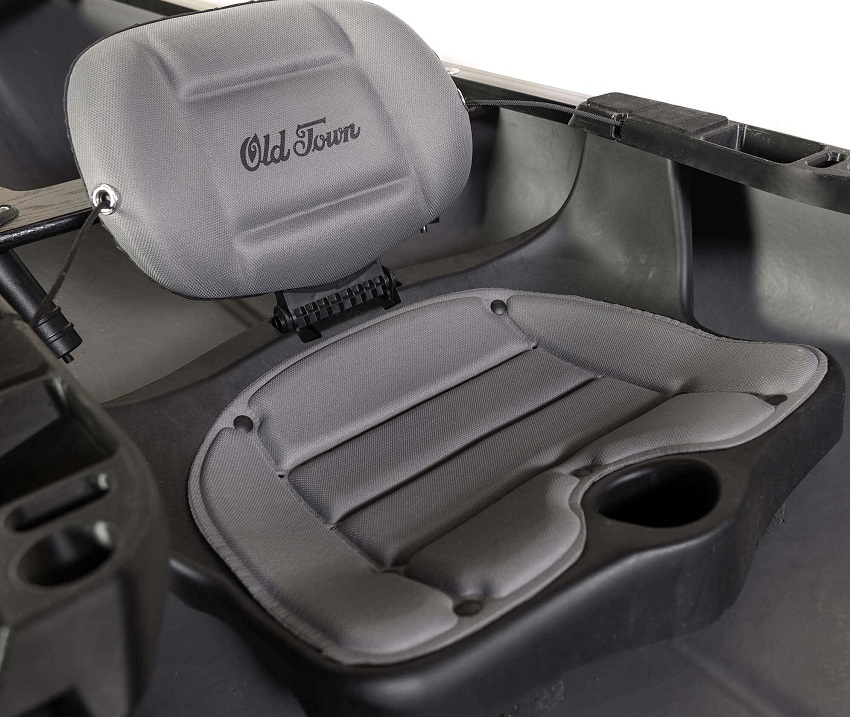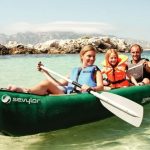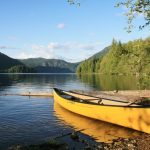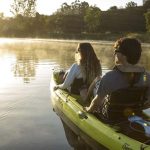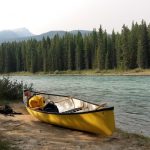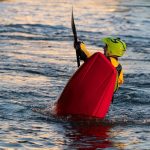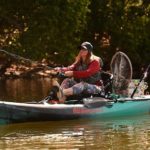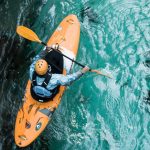Inflatable canoes are easy to transport and store. Here is our list of the best inflatable models to help you make the right choice.
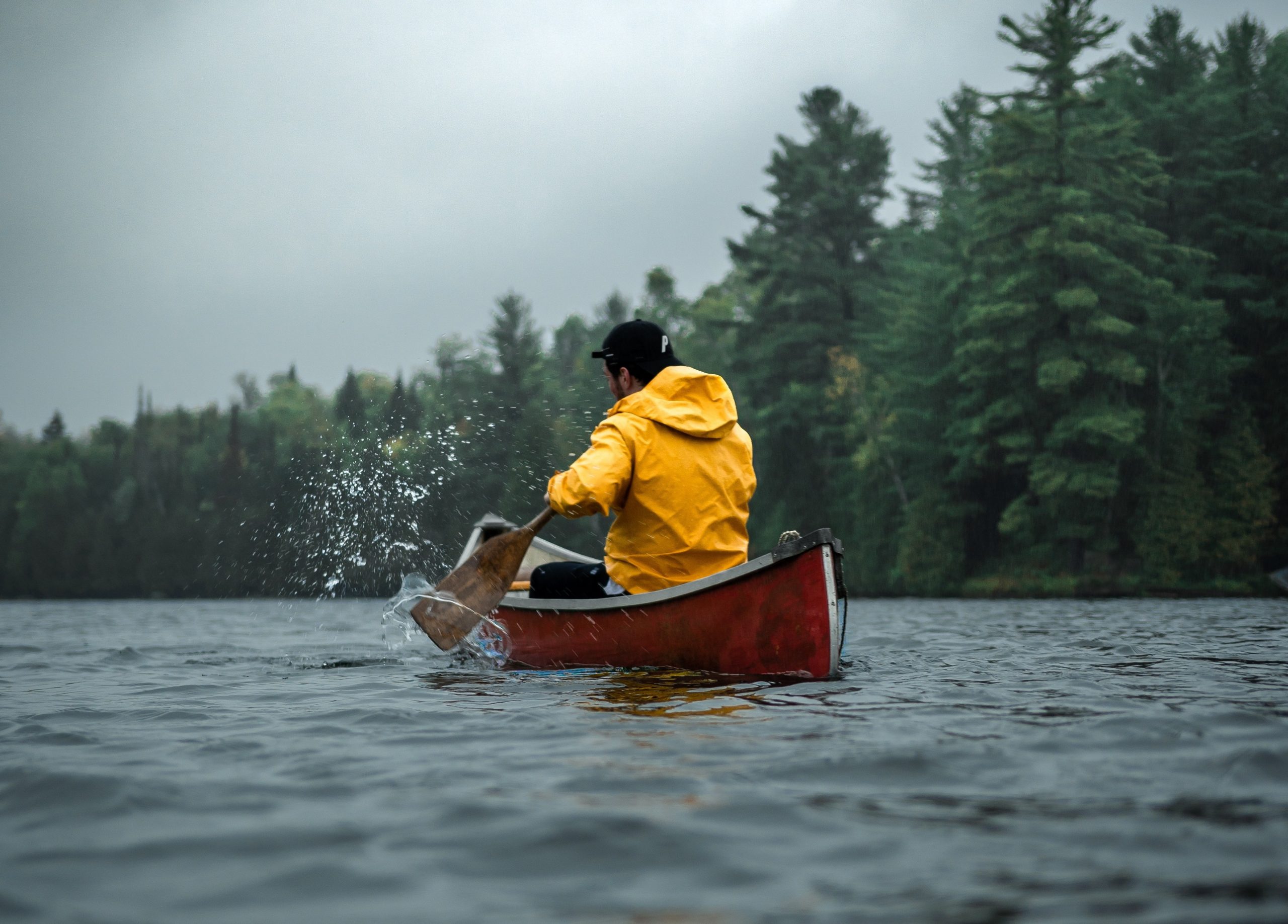
Solo canoeing is one of the most serene ways to explore the water. Propelling yourself along with almost effortless grace from your raised position makes you feel like a good old-fashioned adventurer. From relaxing recreational days to long solo trips in the wilderness, the canoe can take you just about anywhere you want to go.
Solo canoeing isn’t always easy though. Controlling up to sixteen feet of canoe requires patience and the learning of the J-stroke to avoid switching sides every few strokes. The process can be daunting, but you can make it much easier by buying the right solo canoe. Here’s our list, then, of the best solo canoes so you can master the art of single-bladed journeying.
As an affiliate of Amazon and other retailers, we may earn a small commission when you buy via our links, at no additional cost to you. Thank you!
The Best Solo Canoes At A Glance
- Best All-Around: Old Town Discovery 119
- Best Fishing: Old Town Sportsman Solo Discovery 119
- Best Inflatable: Sea Eagle TC16
- Best Tripper: Novacraft Prospector 15
- Best White Water: Esquif Pocket Canyon
- Best Lightweight: Wenonah Wilderness Ultralite
- Best Durability: Grumman 12’9 Solo
Best Solo Canoes
Best All-Around: Old Town Discovery 119

Length: 11 ft. 9 in. (3.6 m)
Width: 32.5 in. (82.6 cm)
Weight: 50 lbs. (22.7 kg)
Capacity: 500 lbs. (226.8 kg)
Material: Three-layer polyethylene
Compact, fun, and easy to paddle, the Old Town Discovery 119 is among the best all-around solo canoes on the market. Old Town Canoes are among the best-known and most historic canoe manufacturers in the world and the Discovery range is their flagship boat.
The Discovery 119 features a single-seat, positioned near the middle of the canoe, as well as two thwarts for structural support. Deck plates at either end are fitted with molded carrying handles, either for paired carrying or for pulling along on a trolley.
A three-layer polyethylene build keeps the weight of the Discovery 119 down to a manageable 50 lbs while giving it enough strength for rivers and years of use. The Discovery 119 is best suited to recreational paddling and rivers, as the shorter length will limit the top speed. However, the sleek design and high capacity make it great for single-night trips.
Pros:
- All-around design
- Strong and lightweight design
- The central seating position gives you maximum control
Cons:
- No carrying yoke
- Shorter length limits top speed
Best Fishing: Old Town Sportsman Discovery Solo 119
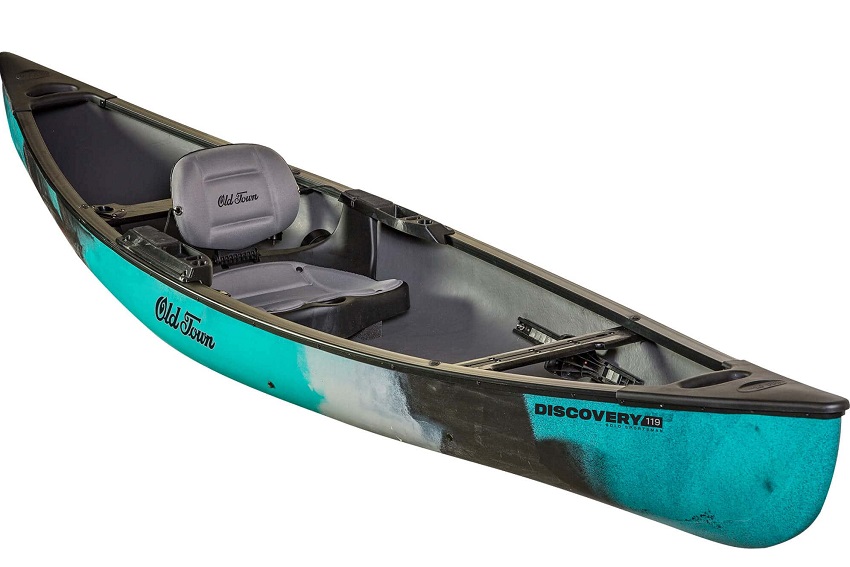
Length: 11 ft. 9 in. (3.6 m)
Width: 32.5 in. (82.6 cm)
Weight: 56 lbs. (25.4 kg)
Capacity: 354 lbs. (160.5 kg)
Material: Three-layer polyethylene
The Old Town Sportsman Discover Solo 119 is a lightweight, easy-to-paddle solo canoe designed for hunters and anglers. This canoe is stable enough to stand and cast, and haul in your catch while being nimble enough to move between fishing spots. The shorter length of the Sportsman Discovery Solo 119 makes it lighter and easier to handle but does limit the top-end speed. If you prefer to cover greater distances on the water while you fish, you might want to consider a longer canoe.
The comfortable, kayak-style seat gives you greater command over the water and adjusts to give you all-day comfort. Any water that collects on the seat is channeled towards two drainage holes at the rear of the seat, so you stay dry. The Sportsman Solo features adjustable foot braces, as well as flush-mounted rod holders and recessed accessory mount tracks.
Inside the hull itself, there is enough space for crates or coolers to fit easily. This hull is made from triple-layer polyethylene, strong enough to withstand years of use on rivers and lakes.
Pros:
- Easy to paddle
- Comfortable padded seat
- Onboard space for crates and coolers
Cons:
- Limited top speed
- No onboard organization for fishing tackle
Best Inflatable: Sea Eagle TC16
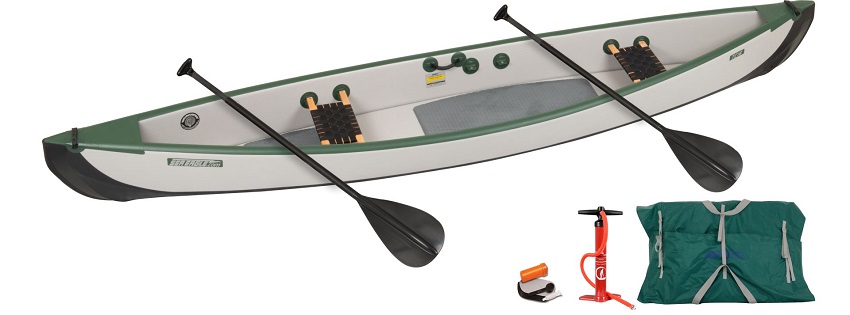
Length: 16 ft. (4.88 m)
Width: 38 in. (97 cm)
Weight: 64 lbs. (29 kg)
Capacity: 915 lbs. (415 kg)
Material: 1000 Decitex Reinforced
When it comes to making inflatable canoes and kayaks, Sea Eagle is among the best on the market. The TC16 is their first canoe built using drop stitch technology. These reinforced seams allow you to inflate the TC16 up to 10 PSI, giving it the feel and response of a rigid canoe.
Inflatable canoes suit canoeists with limited storage and transport options. Unlike traditional models, the TC16 can be deflated to fit in the trunk of a car, or bed of a truck, and stored in a cupboard or corner of a garage. With inflation taking under ten minutes, you can be on the water almost as quickly as you would be anyway.
Inflated, the TC16 is a wide and stable platform that suits canoeists of all levels. This canoe comes with multiple seats that can be moved and removed, giving you the option of paddling with a partner, or solo. This makes the TC16 a great option for families, who may want the choice.
Pros:
- Inflatable and easy to transport and store
- High-pressure design for rigid feel
- Multiple seating choices
Cons:
- Inflatable canoes are more affected by the wind
- Not the easiest canoe to learn to paddle solo
Best Tripper: Nova Craft Prospector 15 Tuff Stuff
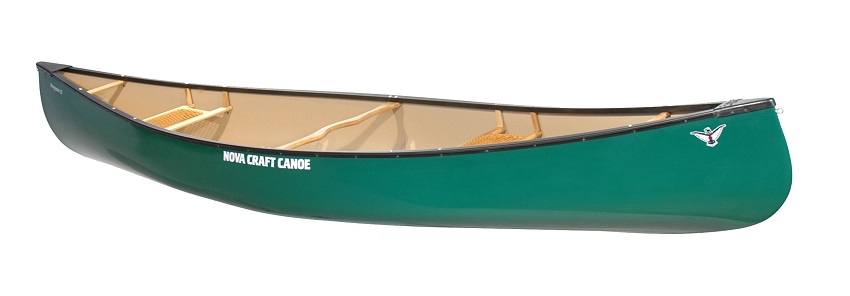
Length: 15 ft. (4.57 m)
Width: 36 in. (91.4 cm)
Weight: 54 lbs. (24.5 kg)
Capacity: 850 lbs. (386 kg)
Material: TuffStuff Composite
The Nova Craft Prospector 15 is their scaled-down, solo version of the popular expedition model, the Prospector 16. Almost every company has a prospector range, based around the original trapper-style canoes. This canoe balances ease of paddling and white water aptitude against straight-line speed and excellent tracking.
Although this canoe is at home for recreational days out, it’s on trips that it really comes into its own. Although the TuffStuff model isn’t the lightest in the range, it is built to withstand the rugged conditions that the trail subjects it to. If your canoe trip takes you through really rough, or remote terrain, consider the TuffStuff Expedition model which is even more heavy-duty.
RELATED: Canoe Camping: The Ultimate Guide
As standard, the Prospector 15 comes with two seats, but this can be changed easily to fit a kneeling thwart. This canoe does also perform as a tandem canoe for families and couples, but if you’re going to load it up with trip gear, it’s best as a solo canoe.
Pros:
- Excellent balance of straight-line speed and maneuverability
- Durable and trip-ready build
- Suited to canoeists of all levels
Cons:
- Expedition model is heavy to carry on portages
Best White Water: Esquif Pocket Canyon
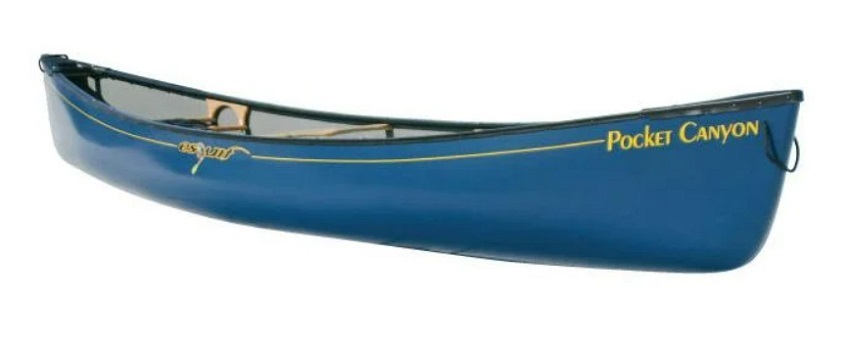
Length: 14 ft. 5 in. (4.42 m)
Width: 34.5 in (87.6 cm)
Weight: 59 lbs. (26.8 kg)
Capacity: 770 lbs. (350 kg)
Material: T-Formex
The Esquif Pocket Canyon is designed to tackle the gnarliest white water rivers around. The Pocket Canyon is a day-tripper, rather than an overnight canoe, perfect for trips that don’t require the length and bulk of a tripping canoe. Although sold as a tandem canoe, this makes for an excellent solo white water canoe.
The capacity of the Pocket Canyon lends itself to white water overnight trips, too. You might want to pack a little lighter to retain the canoe’s playfulness, but with a capacity of 770 lbs., you won’t have to forego many luxuries. The strong T-Formex build means you won’t have to worry about the rocks bashing as you negotiate the river.
The flared hull and rocker profile of this canoe guarantee you a drier ride through the rapids and enhanced finite control to make tight turns. This canoe will carve into eddies, surf on a wave, or just get you down the river with a smile on your face.
Pros:
- White water-specific canoe
- The high rocker profile and flare chines for a drier ride
- Capacity suits overnight river trips
Cons:
- Not suited to open water with limited top speed and tracking capabilities
- Heavy
Best Lightweight: Wenonah Wilderness Ultralite
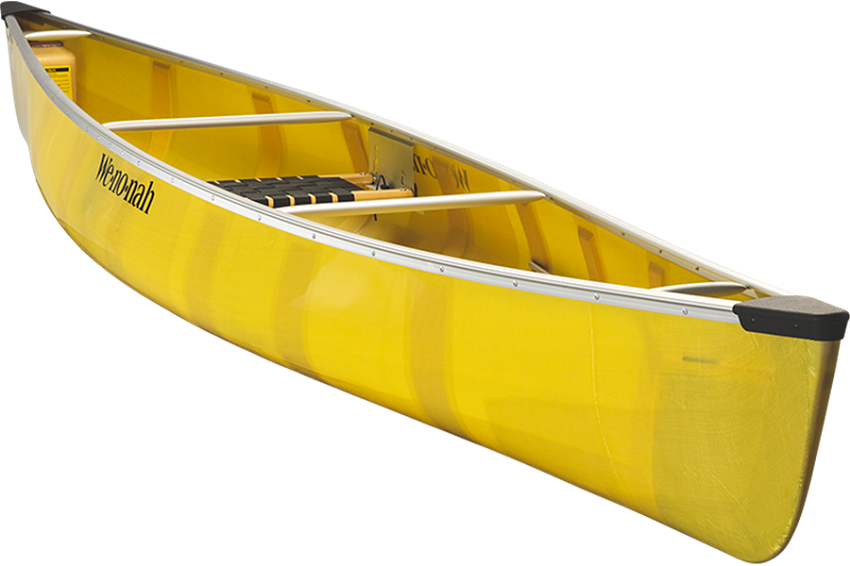
Length: 15 ft. 4 in. (4.67 m)
Width: 30.5 in. (77.5 cm)
Weight: 30 lbs. (13.6 kg)
Capacity: Not stated
Material: Aramid
The Wenonah Wilderness Ultralite is designed to be the ultimate solo open water tripper. This lightweight canoe is easy to load up, almost effortless to paddle, and great on the portages too. The narrow profile of the Wilderness Ultralite gives it an excellent top speed over the water, but will limit the stability for beginner paddlers.
Although Wenonah is reluctant to attribute a specific capacity to any of their canoes, this is a tripping-specific canoe. With that in mind, you can be sure that this is capable of hauling a reasonable amount of tripping gear with you.
Aramid is the material used in aerospace engineering and for bulletproof vests. This strong and lightweight material is capable of withstanding a great deal of abuse, though you’ll be more cautious dragging it through the wilderness than you would be with a plastic canoe. This high-tech material doesn’t come without an associated price tag, and this is one of the most expensive canoes on the market.
Pros:
- Extremely lightweight
- The sleek design gives excellent top speed and tracking
- Excellent solo tripping canoe
Cons:
- Expensive
- No specific capacity stated
Best Durability: Grumman 129 Solo

Length: 12 ft. 9 in. (3.88 m)
Width: 29.5 in (75 cm)
Weight: 48 lbs. (21.7 kg)
Capacity: 585 lbs. (265 kg)
Material: Kevlar
The Grumman 129 Solo may bring about memories of something you paddled at summer camp when you were younger. These kevlar-constructed canoes are firm favorites with families and canoe camps around the world for their durability and easy paddling.
The low profile of the Grumman 129 couples with the diminutive dimensions to give you a canoe that is suited to open water or river trips. It might not be the widest canoe on the list, but the Grumman 129 is stable enough for canoeists of all levels to feel comfortable.
Inside, there is a single aluminum seat and two thwarts, for structural support. This canoe has a generous capacity and doubles as a sturdy tripper, angling, or hunting canoe. This canoe will last long enough that you’ll be handing it down to your children and maybe even grandchildren in the future.
Pros:
- Hard-wearing kevlar build
- Easy to paddle
- Good capacity
Cons:
- Not the best seating system
Buyer’s Guide
In calm conditions, you can get away with solo paddling just about any canoe, for short journeys at least. If you regularly paddle with a partner, there are tandem canoes that can be comfortably used as a solo canoe infrequently. For those who are predominantly going to be solo canoeing, there are certain features to look out for in your solo canoe before you buy.
Length
The length of your canoe will impact how fast it paddles in a straight line. Canoes with longer waterlines are faster over the water and will tend to track more effectively to stay on course. How effectively your canoe will track against the wind is affected by length, as well as other features.
A longer canoe can feel unwieldy at first and may be harder to control. Shorter canoes are better for conditions where you have to make tight turns, like on the river. Most solo canoes are between 13 – 15 feet long. 13 feet models suit recreational and river canoeing, while the 15 feet canoes are better suited to tripping.
Width
Wider solo canoes are more stable than narrower canoes. Canoe anglers and recreational canoeists benefit from this stability the most. Whether you’re standing to cast, or sitting on the raised seats that these styles of canoe often come with, your center of gravity is higher and you need a wide, stable, canoe to feel secure.
The drawback to a wider canoe is that with so much extra boat in contact with the water, you’re going to experience more drag. This may not amount to much over short distances, like on your local lake, but translated into a two-week-long trip, you will feel the difference.
Freeboard
The freeboard of a canoe is the technical name for how deep your canoe sits. It’s the section of canoe between the hull and the gunwales. A greater freeboard means a deeper canoe, which often, but not always, equals a higher capacity.
Canoes with more freeboard are usually more suited to being loaded up for trips and will often give a drier ride against waves on rivers or windy lakes. However, these higher canoes are more affected by wind, especially when they’re empty, and can impact your tracking. They can also feel harder to paddle, especially for smaller canoeists who may struggle to reach the water comfortably.
Rocker
Rocker is the front-to-back curve of your canoe. A canoe with a low rocker will appear flat, while a canoe with a higher rocker looks more banana-shaped. Most canoes will sit somewhere between the two for better balance, but there are some canoes with extreme rocker profiles.
A lower rocker on a canoe will extend the waterline, making the boat faster and more efficient against the wind. These lower rocker canoes struggle to make tight turns and can feel as though they drag through the water. A higher rocker profile raises the bow and stern out of the water which makes it easier to turn the canoe, as well as ride through waves more easily.
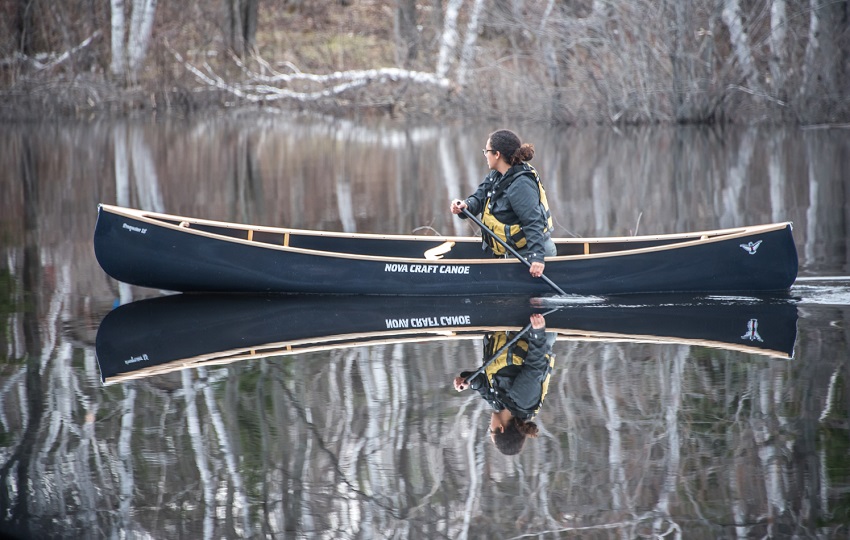
Material
Canoes were traditionally made from wood. Although this is still used by some manufacturers today, most modern canoes are made from plastic, kevlar, or composite materials.
Rotomolded plastic boats are the heaviest canoes on the market, but the molding process makes for a strong canoe that is resistant to impact. Thermoformed canoes use layers of lightweight plastics to create a strong canoe that is lighter than rotomolded models. These canoes are usually more expensive, but the UV-resistant outer layer means they often last much longer.
Composite canoes use fiberglass or carbon to reinforce and stiffen the plastic mold. These canoes are among the most expensive on the market but are always the lightest and most responsive. Due to the stiffness of composite canoes, they do not tend to stand up against impacts.
Kevlar canoes are about as strong as they come. You can dent and bounce a kevlar canoe but you have to really be trying to break through it. These canoes are not as heavy as you might think but tend to have less refined hull shapes due to the molding processes involved.
Weight
Perhaps the biggest challenge most solo canoeists face is that of moving their canoe around while it’s off the water. With some practice, it’s possible to load the canoe up onto your shoulders using the carrying yoke, but many canoeists prefer to use a trolley instead. This isn’t such an issue if you paddle alongside other solo canoeists who can help you to move your canoe around.
If you know you need to move your canoe a long way to get to the water, or you’re heading out on a trip that requires long portages, you will benefit from a lighter canoe. However, these lighter canoes often aren’t as durable as heavier models and tend to come with a higher price tag.
Capacity
Is your canoe designed to carry the weight you want it to carry? When working out the capacity of your canoe, manufacturers look at the load it would take to sink it. To stay within optimal performance, you should avoid overloading 70% of the stated capacity of your canoe.
Your weight isn’t just you, either. Your paddling weight includes all of your canoeing equipment, whether worn items like a PFD or carried gear, like fishing tackle boxes. Account for how much extra you will weigh if you get wet, too.
Seating
Traditionally, canoes were designed to be paddled kneeling down. Kneeling lowers your center of gravity and increases your stability, as well as giving you a better position to power your canoe. Often, solo canoes will use a kneeling thwart, a thin, angled piece of wood, that you can rest your butt on and tuck your feet underneath.
Many modern canoeists prefer to sit in their canoe, at least part of the time. If you regularly switch between kneeling and sitting, an angled seat can provide the best of both worlds.
Canoe seats come in two main styles; plastic, and webbing. Molded plastic seats are the most common and most robust, but are less comfortable on long journeys and don’t breathe. Webbing seats, with webbing strap slung between two wooden thwarts, are comfortable and breathable but don’t last as long as plastic seats.
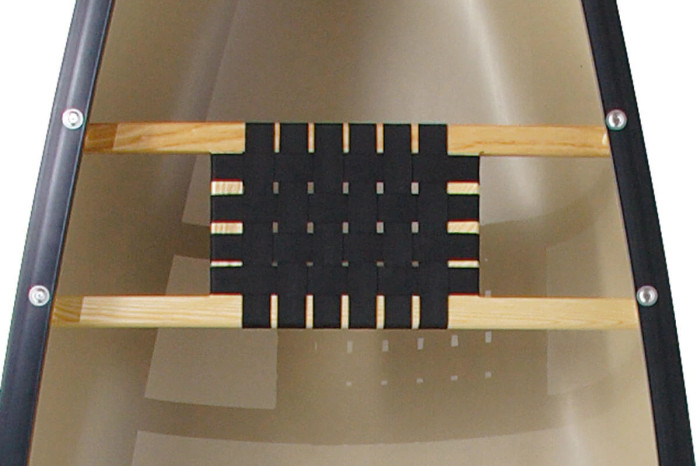
Some modern canoes, especially fishing models, have full seating systems in them like those in a kayak. These are excellent for long days on the water where you need a comfortable seat to cast from. Compared with other seats, they are heavy and aren’t suited to refined paddling for long trips or river canoeing.
